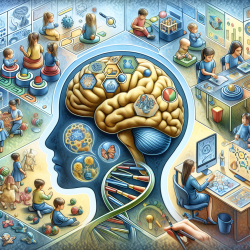Introduction
As a Special Education Director, staying informed about the latest research in neuroimaging genomics can significantly enhance our understanding and support for students with autism and schizophrenia. The research article "Dissecting autism and schizophrenia through neuroimaging genomics" offers groundbreaking insights that can be leveraged to improve educational strategies and therapeutic interventions.
Understanding the Research
The study explores both 'top-down' and 'bottom-up' approaches to understanding the genetic and neuroimaging dimensions of autism and schizophrenia. The 'top-down' approach starts with behavioral diagnoses and moves to genetic factors, while the 'bottom-up' approach begins with molecular factors, providing a more nuanced understanding of biological risks.
Key Findings
- Neuroimaging patterns and genomic variants are shared across diagnostic categories, suggesting common molecular mechanisms.
- The study identifies that high-risk neuropsychiatric mutations have significant effects on both neuroimaging and behavioral traits.
- Genomic variants associated with both autism and schizophrenia indicate pleiotropic mechanisms at the molecular and brain network levels.
Implications for Practitioners
For practitioners in special education, these findings underscore the importance of integrating genetic insights into educational and therapeutic planning. Here are some actionable steps:
- Personalized Education Plans: Utilize genetic information to tailor educational strategies that address the unique needs of students with autism and schizophrenia.
- Collaborative Approaches: Encourage collaboration between educators, therapists, and geneticists to develop comprehensive support plans.
- Further Research: Stay updated with ongoing research to continuously refine educational practices and interventions.
Encouraging Further Research
While the current study provides valuable insights, it also highlights the need for more research, particularly in understanding the shared neuroimaging dimensions across psychiatric conditions. Practitioners are encouraged to engage in or support further research initiatives to deepen our understanding of these complex conditions.
To read the original research paper, please follow this link: Dissecting autism and schizophrenia through neuroimaging genomics.










